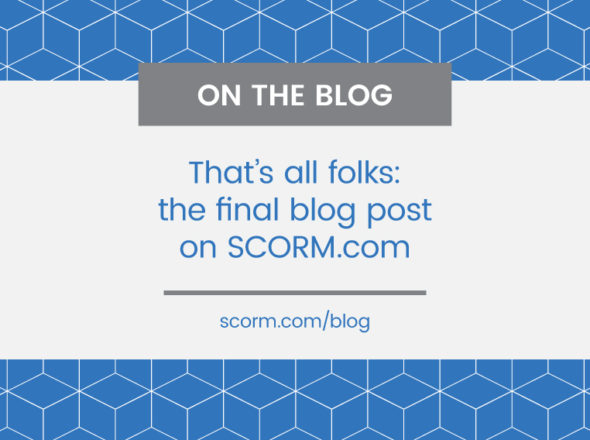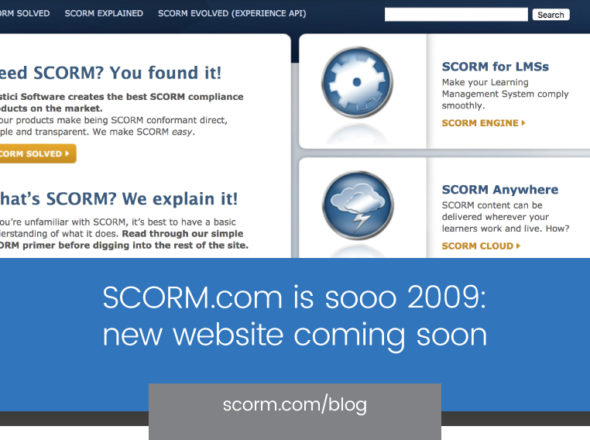Yesterday I talked about what is causing all the confusion coming out of ADL. Today I’ll talk about what it all means.
The Brand
To serve their many masters, the ADL leadership has decided to move away from the SCORM brand. From a business, marketing and adoption perspective, I don’t think it’s a good decision. SCORM is what people know and pay attention to in this industry. Moving away from it requires re-building a brand from scratch…never an easy thing to do. But, the government does what the government does…business, marketing and adoption aren’t really a bureaucracy’s strong suits….bosses, financiers and lawyers are their bigger concerns.
There’s actually really good news coming out of ADL though if you read the messages closely and understand the nuance. Here’s some translation of the messages:
“We’re doing more to support SCORM”
Supporting a standard is a lot of work. ADL maintains a SCORM help desk. They help vendors and organizations understand and adopt SCORM (especially within the government). They maintain a conformance test suite and associated certification programs. They publish best practice guides, example implementations and other documentation. This isn’t a tremendous amount of work, but it isn’t trivial either.
Over the past few years, ADL has been in a transitional phase and frankly a bit of a mess. During that time, these sustaining support activities started to fall through the cracks. When ADL says they are going to do more to support SCORM, they are recommitting to continue to do what they have always done. They are also shifting policy to continue support for SCORM 1.2 (they had previously tried to sunset 1.2 support to encourage 2004 adoption).
When you consider ADL’s color of money concerns, this commitment is actually a rather significant development.
“SCORM isn’t being evolved”
Often re-tweeted as “SCORM is dead” or “SCORM is done”, this the most nefarious of the misinterpreted messages.
SCORM as it is meets the needs of its initial intended use. By and large SCORM-conformant content works in SCORM-conformant LMSs. It isn’t perfect…nothing is…but with the exception of sequencing, it’s pretty darn good. There are a few places where it could be polished, but the changes that would have significant impact require significant additions.
Bearing in mind that the legal concerns over IMS’ intellectual property require that sequencing and content packaging not change, it makes sense to stop putting out new editions of SCORM 2004 and start to focus on SCORM-Next.
“We’re updating the SCORM books”
The SCORM 2004 4th Edition spec manuals need some cleaning up. There are a few inconsistencies, ambiguous statements and diagrams which don’t meet Section 508 requirements. ADL is cleaning up these mistakes and re-publishing the books. Think of this as fixing typos.
There are no changes of substance, they just need to please the English teachers and standards geeks.
“SCORM is going to ISO”
SCORM is an international standard, and believe it or not, it’s not just the US that has annoying bureaucratic rules. In many countries, a standard must be approved by ISO before it can be adopted (imagine that, they want international agreement, not just the dictate of the US DoD!). SCORM 2004 3rd Edition is already published by ISO as a technical report.
ADL will be submitting 4th Edition to ISO to facilitate further international adoption….thus the need to please the English teachers and standards geeks.
“Introducing the Future Learning Experience Project (FLEX)”
And, here we have “SCORM-Next”, only bigger. The FLEX project is ADL’s technology path to achieving the 2025 vision. It is big and has grand aspirations, but it starts with a few small steps. Those first steps build upon SCORM to establish the next generation of learning experience tracking. In other words, let’s build upon the traditional CMI tracking that SCORM enables and track the modern learning experiences that happen in games, simulations, virtual worlds, mobile devices, social networks, etc.
“Participate in Project Tin Can”
Here’s where we come in. Through its BAA program, ADL has funded us to conduct a research program to define the initial experience tracking API. Project Tin Can is an open effort that seeks input from anybody and everybody. Since December we’ve been trying to talk to as many people as we can about what the future of learning looks like. The output of Project Tin Can will be a recommendation for the technology that will be the foundation of FLEX. It is the first piece of the puzzle: the Experience API.
“AICC CMI 5 is defining a new data model”
Somewhere along the way, we left out the good part of the ADL-SCORM history. AICC is another standards organization that contributed IP to SCORM, namely the CMI data model and concepts for the run-time communication. Unlike the ADL-IMS relationship, the ADL-AICC relationship is alive and well.
CMI 5 is another early piece of the FLEX puzzle. AICC is revamping its original CMI data model to enable more generalized and modern tracking. CMI 5 will be an extensible model that adds support for all the new training modalities being considered in Project Tin Can. Its extensibility should also make it a good candidate for tying in new things like performance support data, industry specific extensions, etc.
“Check out LETSI RTWS”
ADL knows that the industry is clamoring for solutions to problems they face today. Many of the shortcomings of SCORM are addressed by the LETSI RTWS SCORM extension. RTWS is a web services communication framework that can be layered on top of SCORM. ADL is currently developing prototypes with RTWS and intends to recommend it as an immediately available solution while FLEX matures.
Some Final Thoughts
Again, these words are my own. These opinions are my own. There is no official ADL opinion, fact or history included herein.
In fairness to ADL, many of these same ideas are clearly articulated on the FLEX project site, here and here.
I think the origin of much of this confusion lies in the fact that for the last couple years ADL has been in a state of flux without a clear public direction. My understanding is that their course is now charted and from here on out the path will be clear.


